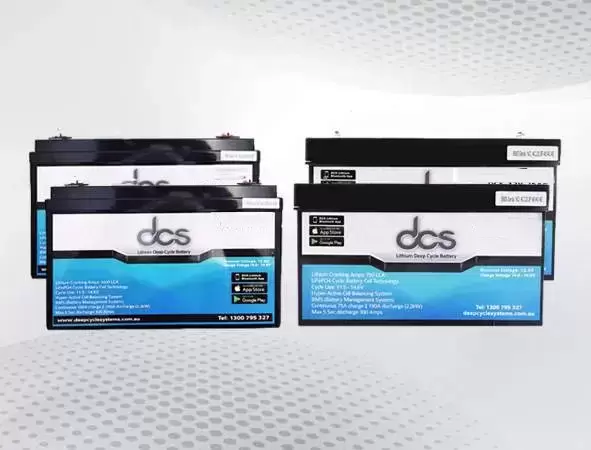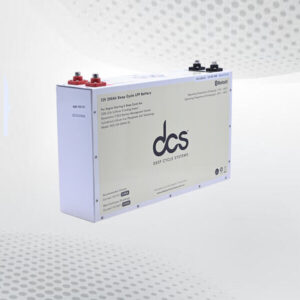When living off the grid, having a reliable power source is essential. Deep cycle batteries are popular for off-grid living, providing a consistent power source for your daily needs. Understanding the ampere-hour (Ah) rating of deep-cycle batteries is crucial in ensuring that you have enough power to meet your energy requirements. This blog post will delve into the world of deep cycle battery Ah, focusing specifically on the 120 amp deep- cycle battery and its significance in powering up your off-grid lifestyle.
Introduction to Deep Cycle Batteries
Deep cycle batteries distinguish themselves by their capability to discharge and recharge repeatedly, making them an indispensable component in off-grid power systems. These batteries are engineered to discharge most of their capacity while maintaining a consistent energy output, unlike standard automotive batteries designed for quick, high-energy bursts to start engines.
The architecture of deep-cycle batteries allows them to provide a steady power supply over a prolonged period. It is ideal for applications requiring sustained energy, such as homes off the grid, recreational vehicles, marine vessels, and remote installations.
The very nature of deep-cycle batteries supports a variety of off-grid living and working situations, offering a reliable energy solution where traditional power sources are unavailable or impractical. This distinct functionality underscores the importance of deep-cycle batteries in achieving a self-sufficient lifestyle by powering essential appliances and systems with renewable energy sources.
Deciphering the Ampere-Hour Rating
The ampere-hour (Ah) rating is a pivotal metric in deep-cycle batteries, offering insight into their energy storage capacity. This rating quantifies how much current a battery can supply over one hour.
For example, a battery boasting a 120 Ah rating can deliver 120 amperes for an hour or 12 amperes over ten hours. This measure is instrumental in determining the suitability of a battery for specific applications, particularly in scenarios demanding sustained power over extended periods.
It enables individuals to make informed decisions regarding selecting a deep-cycle battery that aligns with their energy needs. The Ah rating thus emerges as a fundamental criterion, guiding users in matching the battery capacity with the consumption patterns of their off-grid systems, ensuring a harmonious balance between power availability and the demands of daily usage.
Significance Of The 120 Amp Deep Cycle Battery
The 120 amp deep cycle battery holds considerable significance, particularly for those relying on off-grid energy systems. Here is an exploration under six subheadings:
Sustained Energy Supply
A 120 Ah battery provides a steady and reliable source of power. This is crucial for off-grid setups, where consistent energy availability is key to powering essential appliances and devices over longer periods.
Compatibility with Renewable Sources
These batteries pair well with renewable energy systems such as solar panels and wind turbines. The 120 Ah capacity aligns with the energy output from such sources, ensuring efficient storage and utilisation of generated power.
Enhanced Durability
Batteries with a 120 Ah rating are designed for durability, withstanding numerous discharge and recharge cycles. This resilience is particularly beneficial in off-grid settings, where reliability over time is paramount.
Optimised for High-demand Applications
For applications requiring a substantial power draw, such as running refrigeration units or water pumps, the 120 Ah battery offers the necessary capacity to meet these demands without rapid depletion.
Scalability
Multiple 120 Ah batteries can be connected in series or parallel configurations for larger energy requirements. This scalability allows for creating a customised power storage solution that can grow with increasing energy needs.
Cost Efficiency
Considering its longevity and performance, the 120 Ah deep cycle battery presents a cost-effective solution for off-grid power. Its ability to hold and deliver energy efficiently translates into fewer replacements and maintenance requirements over its lifespan, offering long-term savings.
Comparing Deep Cycle Battery Types
Various deep-cycle battery types are on the market, each tailored to specific requirements and budgetary considerations. Flooded lead-acid batteries are renowned for their cost-effectiveness and widespread availability. However, they require regular maintenance, such as topping up with distilled water.
Sealed lead-acid batteries, including Absorbent Glass Mat (AGM) and gel varieties, offer a maintenance-free alternative. AGM batteries, known for their excellent power density and quick charging capabilities, are a preferred choice for many.
Gel batteries, characterised by their gel electrolyte, provide exceptional durability and resistance to vibration, making them ideal for harsh or mobile environments. Selecting the appropriate type hinges on assessing each variant’s advantages, maintenance needs, and compatibility with the intended application, ensuring a balance between performance and investment.
Charging Recommendations For Deep Cycle Battery 120 Amp Hours
Ensuring optimal performance and extending the lifespan of a deep cycle battery 120 amp hours requires adherence to specific charging recommendations provided by the manufacturer. Overcharging can lead to detrimental effects such as reduced efficiency, while undercharging may not fully replenish the battery’s capacity, leading to diminished performance.
Employing a high-quality battery charger designed for deep-cycle batteries is crucial. Maintaining a regular charging routine is advisable, which helps preserve the reserve’s health and ensures insurers a consistent power output.
Furthermore, the charging process should ideally occur at room temperature to avoid adverse effects of extreme cold or heat on the battery’s chemistry. Understanding and implementing these charging protocols is essential for anyone looking to maximise the utility and durability of their 120 Ah deep cycle battery in an off-grid setup.
Calculating Battery Life Expectancy
Several critical factors influence the life expectancy of a deep-cycle battery, particularly one with a 120 Ah rating. These include the depth of discharge (DoD), which refers to how much of the battery’s capacity is used before recharging; charging habits, which ensure that the battery is neither overcharged nor undercharged; ambient temperature, as extreme conditions can accelerate wear; and adherence to recommended maintenance practices.
For instance, a battery regularly discharged to 50% of its capacity before recharging will generally enjoy a longer lifespan compared to one frequently depleted to 20% or less of its capacity. Moreover, consistent charging and maintenance routines and operation within the manufacturer’s specified temperature ranges can significantly enhance a battery’s service life.
Maintenance Tips for Optimal Performance
Maintaining a 120 Ah deep cycle battery in peak condition involves a series of practices designed to extend its service life and ensure efficient performance. Here are six essential maintenance tips:
Regular Inspection
Checking the battery for signs of wear, damage, or corrosion ensures early detection of issues that could impair performance.
Clean Connections
Keeping the terminals and connections clean and corrosion-free enhances electrical conductivity and battery efficiency.
Proper Charging
Adhering to the manufacturer’s recommended charging practices prevents overcharging and undercharging, which can reduce battery life.
Temperature Considerations
Storing and operating the battery within the recommended temperature ranges protects it against extreme conditions that could reduce its capacity and lifespan.
Equalisation Charge
Periodically performing an equalisation charge for flooded lead-acid batteries balances the cell voltages and prevents electrolyte stratification.
Ventilation
Ensuring adequate ventilation around the battery minimises the risk of gas accumulation and overheating, contributing to safer operation and longevity.
Understanding the Weight and Size Implications
The weight and dimensions of deep cycle batteries, particularly those with a 120 Ah rating, significantly exceed those of standard automotive batteries. This increase in size and mass is attributable to the robust construction and the larger amount of active material required to sustain prolonged discharge cycles.
Such characteristics are essential for delivering a sustained energy supply for off-grid applications. However, this also means that individuals must carefully evaluate the physical constraints of their installations. They must consider the compatibility of these batteries with existing systems and the spatial limitations of the intended installation area.
It is also imperative to assess the structural support where the battery will be placed to ensure it can safely bear the weight. Additionally, the logistics of transporting and manoeuvring these substantial units into position should not be underestimated. They require planning and, in some cases, additional equipment or assistance.
Installation Best Practices For 120 Amp Hour Deep Cycle Battery
Adherence to a set of best practices is paramount when incorporating a 120 amp hour deep cycle battery into an off-grid system, ensuring optimal functionality and safety.
- The battery should be positioned in an area that guarantees adequate ventilation to prevent the build-up of potentially hazardous gases.
- The connections to the power system must be executed precisely, following the guidelines provided by the battery manufacturer.
- It is also vital to ensure that the installation site can adequately support the battery’s weight, given its substantial heft compared to conventional automotive batteries.
- Additionally, it is crucial to consider the spatial requirements and secure the battery to prevent any movement that could lead to disconnections or damage.
- Observing these practices will enhance the performance and efficiency of the 120 Ah deep cycle battery and contribute to a safer energy solution within the off-grid setup.
Safety Precautions and Handling
Handling deep-cycle batteries necessitates caution due to hazardous substances and the risk of electric shock or chemical burns. Protective clothing, gloves, and eye protection should always be worn when performing maintenance or inspections on these batteries.
It is vital to ensure that the workspace is well-ventilated to mitigate the risk of gas accumulation, which could lead to hazardous situations. Additionally, it is important to strictly adhere to the manufacturer’s guidelines during installation and maintenance to prevent accidents.
Proper handling techniques should be employed to avoid dropping the batteries or causing short circuits, which could result in injuries or damage to the battery. Furthermore, individuals should familiarise themselves with the correct procedure for dealing with battery leaks or spills to prevent skin contact with corrosive substances. Safety measures and correct handling protocols are essential to maintaining a secure environment when working with deep-cycle batteries.
Conclusion
Grasping the ampere-hour (Ah) rating, especially for a 120 amp deep cycle battery, plays a pivotal role in efficiently managing energy requirements for an off-grid lifestyle. The selection of a battery with this rating ensures a robust and consistent power supply, which is vital for sustaining daily operations in remote setups. Proper adherence to charging protocols, coupled with diligent maintenance practices, significantly enhances these batteries’ durability and operational efficacy. Safety measures, including correct handling and storage, must be addressed, ensuring a secure environment whilst dealing with deep cycle batteries.
FAQs
What Makes A 120 amp deep cycle battery Suitable For Off-Grid Living?
The 120 amp deep cycle battery provides a reliable and steady power source, crucial for areas lacking access to the grid. Its capacity to deliver consistent energy supports the operation of essential appliances and systems, making it ideal for sustaining daily life in remote locations.
How Often Should A 120 Ah Deep Cycle Battery Be Replaced?
The lifespan of a 120 Ah deep-cycle battery varies depending on usage patterns, adherence to recommended charging protocols, and environmental conditions. With proper maintenance and care, these batteries can last several years before needing replacement.
Can A 120 Ah Deep Cycle Battery Be Used With Solar Panels?
Absolutely. A 120 Ah deep-cycle battery pairs excellently with solar panel systems. It can efficiently store energy generated from solar panels, ensuring a continuous power supply during nighttime or cloudy days. This compatibility enhances the self-sufficiency of off-grid living setups by utilising renewable energy sources.




